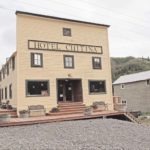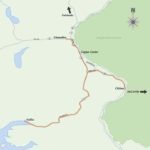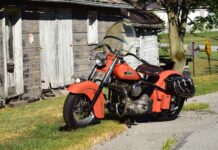Glacial getaway
Touring Alaska’s first major road
Alaska’s Richardson Highway traverses some of the most scenic country in the world. I’d ridden there as part of an 11,000-mile, 31-day journey from my home in Ohio, and if I were asked to rate the various highways in Alaska, I would place the South Segment of the Richardson from Glennallen to Valdez at the top of the list. The history of the Richardson goes all the way back to the Klondike gold rush in 1898. The army explored a route from Valdez to Fairbanks in 1898 and in 1899 work began on a five-foot wide pack trail, later to become the Richardson Highway. In 1913 the U.S. Army dispatched a truck from Valdez to Fairbanks noting they were able to make about 50 miles a day. Roadhouses were built along the trail with one of them still in operation at Copper Center. Today the Richardson is 364 miles long, is completely paved and the 128 miles of the South Segment is designated as one of Alaska’s Scenic Byways.
Riding south 15 miles from Glennallen you will come to the Copper Center turnoff. Copper Center was established in 1896 and the short side trip is well worth your time. The roadhouse that was built that year still stands and is in use today (it was updated in 1932). Miners trying to make it to the Klondike goldfields via the all-American route from Valdez were having a hard time, to say the least. Many perished trying to cross the glaciers, others turned back and a handful made it to Copper Center where they settled and prospected, finding copper in 1900. Copper Center today is much like it was back then.
After spending some time at Copper Center I rode south across the Copper River along Wrangell-St. Elias National Park toward Valdez. Riding south 18 miles, I turned east on Highway 10, known as the Edgerton Highway. The Edgerton will take you about 35 miles to Chitina and another 60 miles to McCarthy. These towns sprang up in the early 1900s when the Kennecott Mining Company started copper mining in the area. Chitina was a thriving community in the early 1900s, with five hotels, a number of rooming houses, a theater and a clothing store. During this same time frame, Anchorage was a tent city.
The ride to Chitina follows the Chitina River and passes through some very remote and beautiful country. In 1938 the mines closed and Chitina became a ghost town overnight. Today you will find the Chitina Hotel as the major business in town. Remodeling of the hotel was started a few years back and was just completed recently. I stopped in for lunch and then explored the old town. Other than the hotel, Chitina is still a ghost town. The old clothing emporium still stands, but is in disrepair as are most of the buildings that are left.
Across the road from the hotel were a number of old car and truck bodies rusting away in a field. After a few pictures I was back to the Richardson and heading south to Valdez, with glimpses of the Trans-Alaska Pipeline on my left. As I rode south I could see the Chugach Mountains in the distance and the darkening skies meant it was going to be a cold, wet ride over Thompson Pass.
Before reaching Thompson Pass, Mount Billy Mitchell comes into view with a large glacier covering the top. General Mitchell explored much of this country by air in the 1920s. Next you will see Worthington Glacier on the right. I took the turnoff to the glacier, parked the bike and was able to walk within a few hundred feet of it. About two-thirds of the way up I could see two climbers working their way to the top. Worthington Glacier is well worth the stop and is designated a national historic site.
From here it was a climb over Thompson Pass as the rain got heavier and started to mix with snow. The peaks were covered with clouds so pictures were out of the question. I instead planned to ride back the next day in the sunshine to enjoy the view and get my pictures.
After descending Thompson Pass the road winds through Keystone Canyon, one of the most challenging parts of the highway—you just can’t beat the scenery. On the left I stopped at a pull-off where there was a sign and a tunnel that was never completed due to a feud punctuated by a gun battle. A little further was a sign depicting the old trail 200 feet above the Richardson that was used until 1945. The trail was just barely wide enough for two horses to pass. As you continue on, Bridal Veil Falls comes into view and cascades hundreds of feet to the river below, with Horse Tail Falls just beyond it on your right. There are a number of pull-offs for the rider to stop and enjoy the scenery as you will see a number of lesser waterfalls riding through the canyon and valley north of Valdez, all being fed by the many glaciers in the area.
When I arrived in Valdez it was still raining so I checked into the Keystone Hotel for two nights. I had planned to take one of the tour boats on Prince William Sound the next day, but after talking to the locals I was informed I was too early for the whales so I decided to spend the next day in Valdez and explore the history of the area. One of my first stops was the Valdez Museum that tells the history of Valdez with many artifacts from the past. The lady at the admission desk said after I had a chance to tour the museum I should head around the corner to their other facility where they were showing a movie detailing the earthquake of 1964 and the ensuing tsunami that wiped out the town. Today the city of Valdez sits on a different, more stable site. What was left of the old city was burned to the ground and many of the residents from 1964 tell their stories in this movie.
After some time at the museum I went to see the Trail of the Whispering Giants totem. More than 70 of these totems have been completed in 50 states, Canada and Hungary. This totem stands 30 feet tall with a width of 10 feet, and it weighs 85,000 pounds.
Since I was not going to take the boat tour I rode back up Thompson Pass and on to Worthington Glacier. The weather was nice and I just wanted to enjoy the beauty of the mountains. Returning to Valdez I turned off on a side road on the edge of town. The road dead-ends a couple of miles up, at the base of Valdez Glacier. Valdez Glacier is not as spectacular as Worthington, but was still a good side trip. Riding back into Valdez I stopped at the old cemetery. Some of the wooden grave markers date back to the late 1800s with many of the names no longer legible. After a good night’s sleep I was up early, headed north to see more of the great state of Alaska.






















